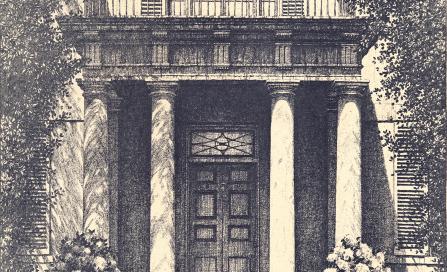|
William Hardy WilsonWilliam Hardy Wilson was born in Campbelltown on the far south west outskirts of Sydney in 1881.Though he spent much of his youth in the Sydney suburbs of Burwood and Stanmore, where he attended Newington School, memories of Sydney’s rural fringe were almost certainly important and formative for the architect. For it was out there that Georgian buildings survived from the early colonial era. And it was to this Georgian architecture that Wilson turned after a trip to Europe and the United States which impressed upon him the beauty of classical and classically-inspired architecture. Conversely, he came to regard Gothic architecture as unsuited to Australia; both because it was a cold-climate style and, by tradition, was not Australian. Within two years of his return to Australia in 1910, Wilson was exploring New South Wales and Tasmania in order to make an ‘architectural record’ of ‘the best Late-Georgian’ structures surviving. These included the house ‘Wivenhoe’ at Cobbitty to the south west of Sydney – one of the beautiful pencil drawings published in Old Colonial Architecture in New South Wales and Tasmania in 1924. In the process Wilson came to consider Georgian architecture as Australia’s vernacular style. His writings and art were an early expression of the need to preserve built heritage. In the meantime Wilson worked with his European and American touring partner, Stacey Arthur Neave, on several Neo-Georgian houses in Neutral Bay. Their symmetrical facades contrasted markedly with the English Revival / Federation styles which had dominated domestic architecture locally, and more broadly in Sydney, since Walter Liberty Vernon built ‘Penshurst’ overlooking Neutral Bay in 1885. Wilson’s designs for ‘Purulia’ and ‘Eryldene’, both in Gordon on Sydney’s upper north shore, ushered in the elegant Georgian Revival style emulated throughout the area through to the 1960s. Wilson’s love of Australia’s early colonial architecture fuelled a passion for preservation. In 1919, when he wrote the introduction for an exhibition of his architectural drawings at Anthony Hordern’s Fine Art Gallery, Sydney’s relentless dynamism had already destroyed many colonial buildings then less than a century old. Within those that survived, Wilson identified the key to a national architectural style and a national identity: 'Some of these buildings are very beautiful; and they are disappearing quickly. Since I made the drawings two of the houses included in this exhibition have been demolished, and others have been altered beyond restoration... Upon these old buildings of ours, which are the stepping stones to greater styles, can be founded better work than that which is being introduced from Chicago or English garden suburbs. Without them we have no familiar past on which to build'. |
|
Architecture responds to more than design and fashion.


